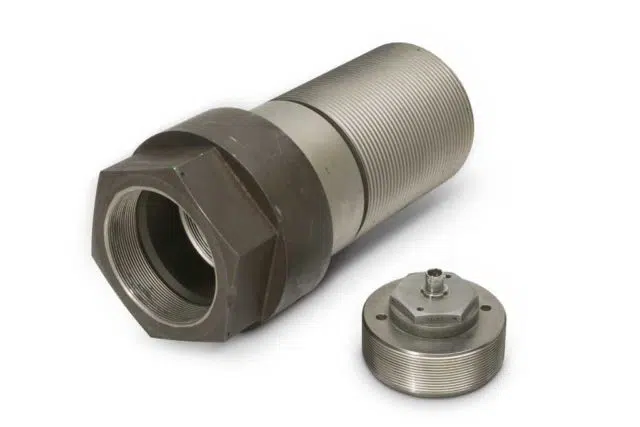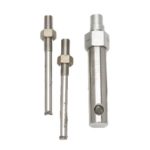Separation Bolt
Product Description
A pyrotechnic separation bolt is a bolt designed to fracture at a specific pre-determined separation point at precisely the right time. The bolt will experience intentional mechanical failure resulting in the planned separation and with contained debris output. Separation bolts are activated by pyrotechnic inputs, such as initiators or pressure cartridges.
Designed for missile, spacecraft and marine applications where rapid structure separation is demanded. Piston actuated and hydrodynamic (pressure amplified) pyrotechnic separation bolts are available in a wide range of sizes, configurations and tensile capacities (from as little as 200 pounds to as much as 1,000,000 pounds). Our engineers are here to support you in meeting your structural loading, envelope and environmental requirements and guide you on ways to mitigate shrapnel and products of combustion.
Key Features
- Various initiation options
- High strength steels
- Various thread sizes
- Less sensitive to its surroundings
- Minimum swelling
- Shrapnel contained
- Immune to malfunction due to vibration
- Withstands high shock loads
- Has no moving parts prior to operation
How A Separation Bolt Works
Separation bolts utilize a pyrotechnic pressure driven piston, internal to the bolt. In piston actuated bolts, the piston travels down the internal counterbore striking the bolt at its break plane effectively pushing the bolt apart. In the case of the hydrodynamic bolt, the piston impacts a hydraulic medium used to amplify the force to effectively pull the bolt apart.
This type of bolt is often used where an ejective force is required in addition to bolt separation and results in a break having minimum swelling of the bolt parts and practically no shrapnel. With separation bolts, more space is required allowing for the internal piston in the head of the bolt. Hydrodynamic bolts are used where any large structural loading is required such as separation of the solid rocket boosters from the Shuttle and SLS main tank.
Piston Actuated bolts have larger space requirements with the combustion products contained within the design and there is no bolt expansion.
Hydrodynamic separation bolt is the most complex of all our bolt designs. The combustion products are contained, again, there is no bolt expansion. These are high tensile bolts.
Piston Actuated Pyrotechnic Bolts
Piston Actuated Pyrotechnic Bolts provide for full containment of products of combustion and for force amplification to permit severance of larger bolts. An explosively driven piston of large surface area impacts a hydraulic medium which fails the bolt due to combined hoop and shear stresses.
► Piston Actuated Bolt: the force of a pressure driven piston exceeds strength at break plane
Hydrodynamic (Pressure Amplified) Pyro Bolts
Hydrodynamic (Pressure Amplified) Pyro Bolts provide for containment of combustion and for amplification to permit severance of larger bolts. An explosively driven piston of large surface area impacts a hydraulic medium which fails the bolt due to combined hoop and shear stresses.
► Hydrodynamic Bolt: the force of pressure driven piston impacts a hydraulic medium used for force amplification to exceed the strength at the break plane
Specifications
- Input Stimulus, Typical
3.5 amp (when electrically initiated)
TLX or SMDC input
4.5 AMP/4.1 millisecond - Tensile Strength
Up to 550,000 lbf - Operating Temperature
Designs as low as -65 °F and up to +270 °F - Separation Time, Typical
<10 milliseconds after application of All-Fire input stimulus
<5 milliseconds at greater currents - Hermesticity (pre-function)
Designs that comply with 1 x 10-6 cc He/sec at 1 atm - Applicable Specifications
Qualified for:- MIL-DTL-23659 Appendix A
- Mil-C-83124
- NASA NHB5300.4(1C)
- Mil-STD-1512
Interface
Separation bolt sizes and configurations can be tailored to meet structural loading, envelope and environmental conditions requirements for specific applications.
Specification Questions
To support mission-critical efforts requiring a rapid separation system via explosive or separation bolts, below are some typical questions we ask in order to ascertain the best possible solution.
- Application – what are you trying to accomplish?
- What are your tensile/shear and torque loads?
- What are your space constraints?
- Is containment required?
- Redundancy requirements?
- Input power requirements – electrical, ETL, mechanical?
- Environmental requirements?
- Qualification requirements?
- Military or other requirements?
FAQ's
-
How do I size the thread?
Give us your tensile strength requirement and we will provide a size
-
What size bolts do you have?
Although we have many sizes of bolts, each bolt is designed for a specific application and tested to their unique shock, vibration, and temperature conditions. So, each bolt design must be reviewed and tailored against its intended application.







